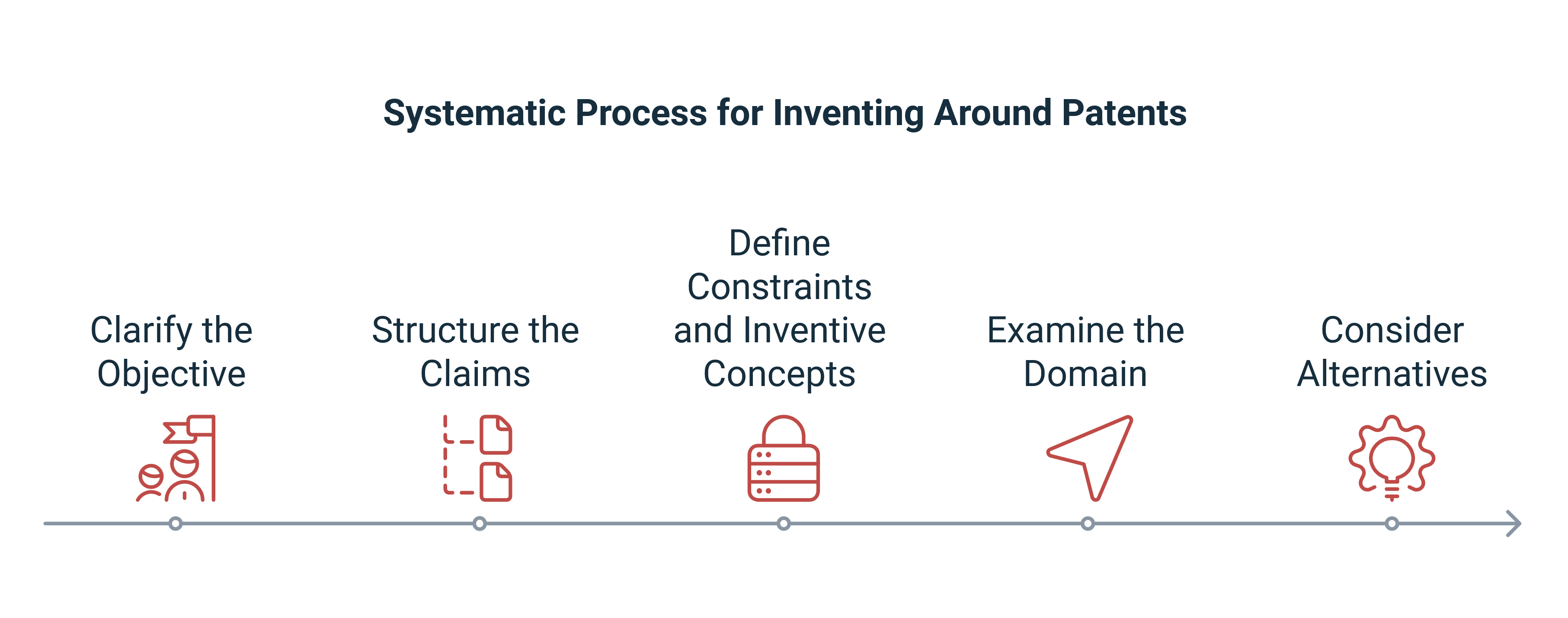
In the dynamic world of technology and product development, innovators often face challenges related to existing patents. Whether due to potential infringement risks, navigating a complex state of the art, or strategic patenting considerations, the need to “invent around” existing patents is a common occurrence. A structured and systematic process in doing that can guarantee that a good performing solution can be found at minimum cost.
The importance of inventing around
Inventing around patents is a crucial skill in the modern innovation landscape. It allows companies and inventors for example to:
- Avoid patent infringement risks
- Navigate crowded technological fields
- Develop unique solutions to existing problems
- Create strategic patent portfolios
While ideally, technology development should begin with a clear understanding of prior art, reality often presents scenarios where potential infringement issues are discovered late in the development process. In such cases, a structured approach to inventing around can be invaluable.
A systematic process for inventing around
The process of inventing around patents can be broken down into five key steps, each crucial for developing effective and non-infringing alternatives. This systematic approach ensures a thorough exploration of possibilities while minimizing the risk of inadvertently infringing on other patents.
-
Clarify the objective
The first step is to clearly define the objectives of your design without reference to potentially infringing patents. This involves:
- Identifying core functions of your product or technology
- Structuring these functions hierarchically
- Describing functions in a solution-neutral manner
This approach ensures focus on fundamental goals rather than specific implementations, opening up possibilities for innovative alternatives.
-
Structure the claims
Examine the patents posing an infringement risk by structuring their independent claims hierarchically. This step involves:
- Breaking down each claim into its constituent elements
- Organizing these elements to reveal the claim’s logic and structure
- Visualizing the relationships between different claim components
This structured approach provides a clear understanding of what needs to be avoided or reimagined in your new design.
-
Define constraints and inventive concepts
Within the structured claims, identify two key categories:
- Constraints: Elements that cannot be changed and must be worked around
- Inventive concepts: Core ideas that could potentially be implemented differently
This classification helps focus your efforts on areas where alternative solutions are most likely to be found.
-
Examine the domain (other patents)
Conduct a thorough Freedom to Operate (FTO) search to identify and analyze other relevant patents in the field. This step is crucial because:
- It prevents the risk of avoiding one patent only to infringe upon another
- It provides a broader understanding of the technological landscape
- It may reveal alternative approaches already explored by others
This comprehensive review ensures that your inventing around efforts are well-informed and less likely to encounter unforeseen obstacles.
-
Consider alternatives
The final step is the creative heart of the process, where you explore different ways to achieve the desired functionality without infringing on existing patents. This involves:
- Seeking alternative means of implementing key functions
- Exploring different approaches to achieving desired attributes
- Using systematic innovation techniques to generate novel ideas
- Sketching and prototyping promising concepts for evaluation
This step often requires multiple iterations, combining creativity with logical analysis to develop viable, non-infringing solutions. By following these five steps systematically, inventors and companies can effectively navigate the complex process of inventing around existing patents, potentially leading to innovative solutions and new intellectual property.

Practical example: Inventing around a door/window drive device
To illustrate this process, let’s consider European Patent EP2103766, which describes a “Drive device to operate the leaf of a door or window”. The first claim of this patent reads:

By using existing patent drawings, rearranging them, and manipulating them, the principle of operation and the core inventive step becomes clear in relation to the primary function of the invention. Where necessary recreate the invention in 3D CAD in order for the operation to be clear to everybody, and in order to have a base model to try alternative configurations.

After you have clarity about the operation and structure of the patent that is standing in our way, start to explore what concept elements we can avoid. One by one, examine these elements and the possibilities to substitute or eliminate them. One simple approach is to map each element and simply explore negating it. So in this example, if we examine the element “drive lift off”, consider the possibilities for “drive NOT lifting off”. Each possibility can be sketched up to examine firstly its practicality and effectiveness, and secondly whether this indeed is a safe way around infringement risk.

Key principles for successful inventing around
- Thorough Understanding: Before attempting to change anything, ensure a clear and in-depth understanding of the existing structure.
- Solution-Neutral Thinking: Focus on the core functions and desired outcomes rather than specific implementations.
- Creativity and Lateral Thinking: Be open to different approaches that achieve the same end result.
- Systematic Documentation: Keep detailed records of your inventing around process, including all alternatives considered.
- Legal Consultation: Always consult with patent attorneys to ensure your workaround truly avoids infringement.
Challenges and considerations
While inventing around can be an effective strategy, it comes with its own set of challenges:
- Technical Complexity: Some patents may be difficult to work around without sacrificing performance or efficiency.
- Time and Resource Constraints: The process can be time-consuming and may require significant R&D investment.
- Patent Thickets: In some fields, dense networks of overlapping patents can make inventing around particularly challenging.
- Maintaining Competitiveness: Workarounds must not only avoid infringement but also remain commercially viable.
Inventing around patents is a valuable skill in today’s innovation-driven economy. By following a systematic process that includes clarifying objectives, analyzing existing patents, conducting thorough FTO searches, and creatively exploring alternatives, inventors and companies can navigate the complex patent landscape more effectively.